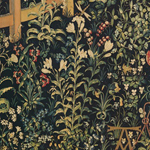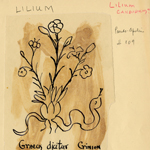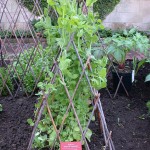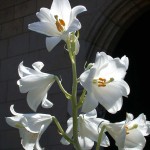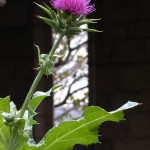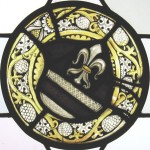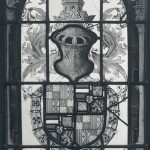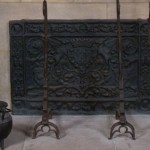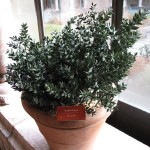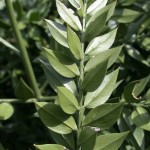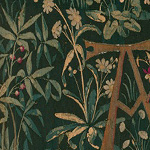Posts Tagged ‘lily’
Friday, May 25, 2012
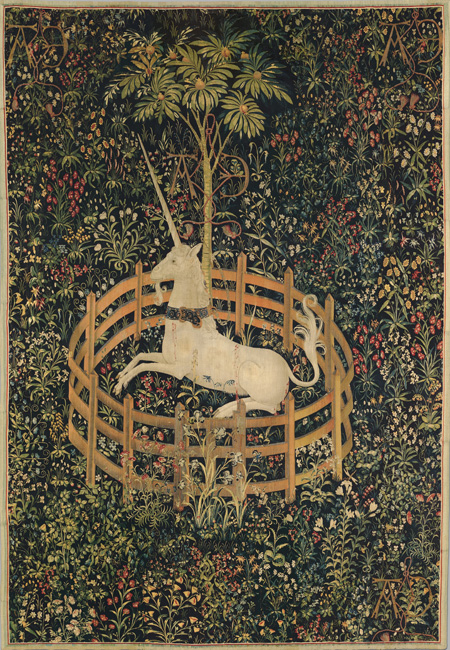
The Unicorn in Captivity, 1495???1505. The Metropolitan Museum of Art, New York, Gift of John D. Rockefeller Jr., 1937 (37.80.6). The profusion of flowering plants that springs from the millefleurs meadow on which the unicorn rests includes both garden plants and wildflowers. An iris and a clove pink are prominently placed outside the unicorn’s enclosure; both were intensively cultivated in the Middle Ages, but the purple orchis silhouetted against the unicorn’s body depends on a special relationship with microorganisms in its native soil and would not have grown in gardens.
Roses, lilies, iris, violet, fennel, sage, rosemary, and many other aromatic herbs and flowers were prized for their beauty and fragrance, as well as their culinary and medicinal value, and were as much at home in the medieval pleasure garden as in the kitchen or physic garden. These plants were carefully cultivated, but many useful plants of the Middle Ages were found outside the garden walls, or admitted on sufferance.
Read more »
Tags: colewort, Fennel, gourd, herb, Hortulus, iris, kale, lamb's quarters, lettuce, lily, melon, nettle, poppy, pulse, purslane, rose, rosemary, sage, violet, Walahfrid Strabo
Posted in Food and Beverage Plants, Fragrant Plants, Medicinal Plants, Plants in Medieval Art, Useful Plants | Comments (1)
Saturday, February 5, 2011


Above: Two details from a tapestry-woven praetexta (Germany, Cologne, about 1450-75) currently on display at The Cloisters. The??flower shown at the center??of the detail on the??left is a fantasy.??The detail on the??right??shows a botanically unmistakable lily;?? a strawberry, embellished with a fanciful??and botanically incorrect??element at the??bottom of the fruit,??appears just below and to the left of the lily.?? See the full image.
A plant in a medieval work of art need not be naturalistically depicted to be recognizable. Even a very stylized representation may have characteristics so distinctive that it can be given a botanical identity with complete confidence. Read more »
Tags: achene, berry, Fragaria vesca, hull, lily, Narcissus pseudo-narcissus, seeds, strawberry
Posted in Plants in Medieval Art, Useful Plants | Comments (0)
Monday, November 22, 2010
Above from left to right: Margaret Freeman in her office at The Cloisters in 1938; a large and lovely rendering of Lilium candidum prominently placed in the flowery field below the enclosure of the Unicorn in Captivity; tracing of a woodcut image illustrating the entry for the same species of lily, taken by Freeman from the herbal of Apuleius Platonicus, sometimes known as the Pseudo-Apuleius. The Latin subscription states that this lily was known to the Greeks as “Crinion.”
This is not the lily which today is and tomorrow is cast into the oven; it will blossom for ever.
???Saint Bernard of Clairvaux, Sermon 70 on the Song of Songs, III.6
Margaret B. Freeman was associated with The Metropolitan Museum of Art for fifty-two years, first as a lecturer at the old Cloisters in 1928, then as a curator, and eventually as director of The Cloisters in 1955, succeeding James Rorimer. Charged with the development of the gardens, Ms. Freeman was perhaps the single most important contributor to the list of medieval plants drawn from historical sources, which is still in use here. Read more »
Tags: Crinion, James Rorimer, Lilium candidum, lily, Margaret Freeman, Pseudo-Apuleius
Posted in Gardening at The Cloisters | Comments (4)
Friday, October 15, 2010
Many of the healing herbs, flowers, and foodstuffs mentioned by the twelfth-century Benedictine abbess Hildegard of Bingen in her great work Physica are grown in Bonnefont garden at The Cloisters. Above, from left to right: Field peas (Pisum sativum arvense,??variety ‘Blue Pod Capucijners’); Madonna lily (Lilium candidum); milk thistle (Silybum marianum).?? Photographs from the Gardens archives.
It is the first book in which a woman discusses plants and trees in relation to their physical properties. It is the earliest book on natural history to be done in Germany and is, in essence, the foundation of botanical study there. It influenced the 16th-century works of Brunfels, Fuchs, and Bock, the so-called ???German fathers of botany,??? but the fact is that German botany is more indebted to a ???mother.???
???Frank Anderson on the Physica, from An Illustrated History of the Herbals
Certain plants grow from air. These plants are gentle on the digestion and possess a happy nature, producing happiness in anyone who eats them. They are like a person???s hair in that they are always light and airy. Certain other herbs are windy, since they grow from the wind. These herbs are dry, and heavy on one???s digestion. They are of a sad nature, making the person who eats them sad. They are comparable to human perspiration. Moreover, there are herbs which are fatal as human food . . . they are comparable to human excrement.
???From Book I of the Physica, translated by Priscilla Throop
Hildegard of Bingen, Benedictine abbess, visionary, poet, dramatist, composer, and the most learned woman of the twelfth century, wrote the Physica, or Natural Science, about the year 1150. Read more »
Tags: Bonnefont Garden, field peas, Hildegard von Bingen, lily, medicinal plant, milk thistle, Silybum marianum
Posted in Botany for Gardeners, Gardening at The Cloisters, Medicinal Plants, Plants in Medieval Art | Comments (4)
Monday, April 26, 2010
It’s always a special joy to be at The Cloisters in the spring when the stirring and bursting of the plants in the gardens heralds the arrival of nature’s new season with such festive trumpets of color. The reflection of the garden’s plants in the Museum’s collections is wide and well recognized, especially to those who are frequent, or even occasional, visitors to the flowered meadows of the Unicorn Tapestries or the exuberant borders of the Belles Heures of the duke of Berry. One place that shouldn’t be overlooked while visiting The Cloisters, though, is the field of heraldry. Read more »
Tags: fleur-de-lis, fleur-de-lys, heraldry, Iris pseudacorus, Lilium candidum, lily, loys, Song of Solomon
Posted in Plants in Medieval Art | Comments (9)
Friday, January 22, 2010
Above, from left: Butcher???s broom growing in a pot indoors in Cuxa Cloister; detail of the stiff, sharp “leaves,” which are actually modified stems; detail from the tapestry The Hunters Enter the Woods showing Butcher’s broom.
An odd-looking little shrub, Butcher???s broom (Ruscus aculeatus), which reaches a height between one and a half and two feet for us here at The Cloisters, was also known as knee-holly, because of its short stature and prickly nature. (Another old name is “pettygree” or “pettygrew.”) Usually included in the very large lily family, butcher???s broom is a botanical curiosity as well as a household and medicinal plant with a long history of use. Read more »
Tags: asparagus, butcher's_broom, lily, Ruscus_aculeatus
Posted in Gardening at The Cloisters, Medicinal Plants, Useful Plants | Comments (0)
Friday, March 27, 2009
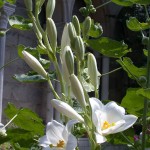
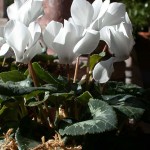
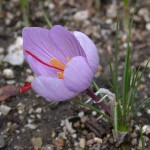
Above, from left to right: Madonna lily (Lilium candidum), cyclamen (Cyclamen persicum), and saffron crocus (Crocus sativus) in Bonnefont Herb Garden.
Many bulbous plants are grown in the gardens of The Cloisters throughout the seasons. In addition to their place in the collection as medieval species, they prolong the garden???s ornamental value, often blooming when there are no other flowers to be seen. The snowdrops (Galanthus nivalis) enliven Bonnefont Herb Garden while there is still snow on the ground. Certain bulbous plants, like the fall-blooming saffron crocus (Crocus sativus), possess a rich history that our garden lecturers are eager to discuss. However, the saffron crocus is actually not a true bulb, but actually what is known as a “corm.” Read more »
Tags: Bulbs, corm, Crocus, cyclamen, geophyte, lily, rhizome, spring bulbs, true bulb, tuber
Posted in Botany for Gardeners, Gardening at The Cloisters | Comments (1)





